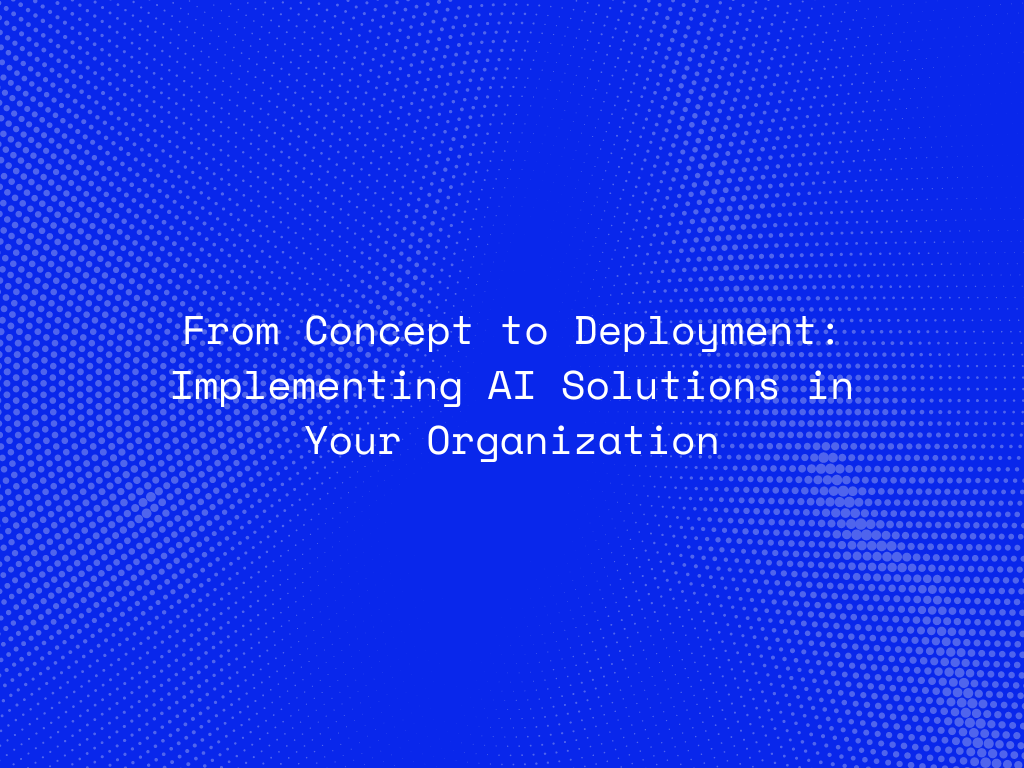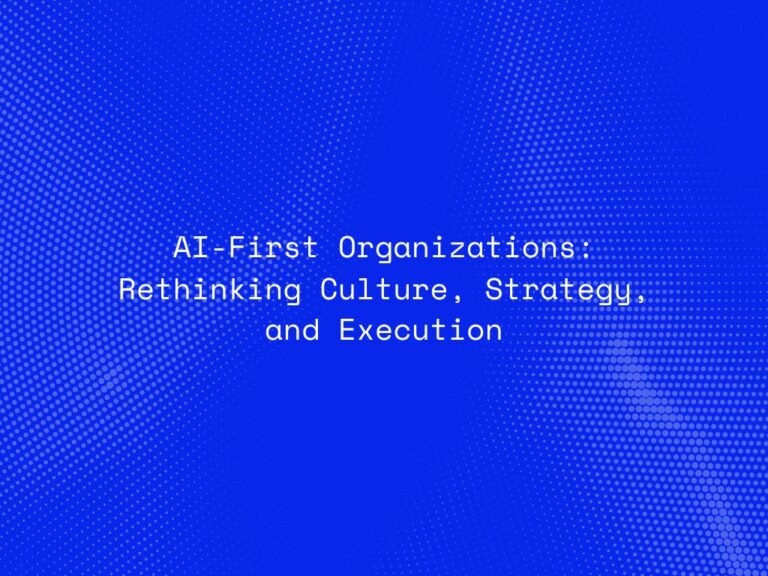Artificial intelligence (AI) is no longer a futuristic concept but a practical tool for businesses across various industries. From automating mundane tasks to uncovering deep insights from data, AI has the potential to transform organizations. However, successfully implementing AI solutions—from concept to deployment—requires a strategic approach. This guide will walk you through the steps of integrating AI into your organization and offer best practices for a smooth and effective rollout.
1. Defining Your AI Strategy: Aligning with Business Goals
a) Identifying Business Problems AI Can Solve
Before diving into AI technologies, it’s critical to define the business problems you’re aiming to address. AI solutions are most impactful when they solve real, tangible issues. Understanding where AI can add the most value ensures alignment with your organization’s strategic goals.
Use Cases Across Industries: AI can be used for various purposes, such as automating repetitive tasks in manufacturing, personalizing marketing campaigns, or improving customer service with chatbots. Define your specific needs to determine where AI can make a difference.
Measurable Objectives: Establish key performance indicators (KPIs) to measure the success of your AI implementation, such as improved operational efficiency, enhanced customer experience, or increased revenue.
b) Choosing the Right AI Applications
There are many types of AI solutions, such as machine learning (ML), natural language processing (NLP), computer vision, and predictive analytics. The challenge is selecting the right tools for your business objectives.
Machine Learning for Predictions and Insights: Use ML models to analyze data, forecast trends, and generate actionable insights. For example, ML can predict customer behavior, optimize supply chain operations, or detect fraud.
Natural Language Processing for Automation: NLP can be deployed in chatbots or virtual assistants to automate customer queries, process large amounts of unstructured text, or perform sentiment analysis.
2. Building a Strong Data Foundation
a) Data Collection and Management
AI’s effectiveness is driven by data, and having a robust data management strategy is essential. Start by identifying the data you’ll need to feed into your AI models, whether it’s customer behavior data, sales data, or operational metrics.
Data Sources: Ensure you have access to diverse and relevant data sources, such as CRM systems, IoT devices, social media, or internal databases. Clean and structured data is essential for accurate AI predictions.
Data Governance: Establish a data governance framework to ensure data quality, security, and compliance with regulations such as GDPR or CCPA. This will help mitigate the risk of biased or erroneous AI outputs.
b) Data Infrastructure: Scalability and Flexibility
Invest in the right data infrastructure to support AI applications. This includes data storage solutions that can handle large volumes of data and cloud platforms that offer scalable computing resources.
Cloud Solutions: Cloud platforms like AWS, Google Cloud, or Microsoft Azure offer AI-as-a-Service tools that provide scalable data storage, processing power, and AI models without the need for in-house infrastructure.
Data Pipelines: Build data pipelines that automate the collection, cleaning, and transformation of data. This ensures that your AI models have real-time access to high-quality data for better accuracy.
3. Choosing the Right AI Tools and Platforms
a) Selecting AI Frameworks and Technologies
There are numerous AI tools and platforms available, ranging from open-source libraries to proprietary solutions. Choose AI frameworks that align with your technical capabilities and business requirements.
Open-Source AI Tools: Platforms like TensorFlow, PyTorch, and Scikit-learn offer a wide range of AI models, from deep learning to reinforcement learning. These open-source libraries are highly customizable and free to use, making them ideal for organizations with skilled AI teams.
Proprietary AI Solutions: Companies like IBM Watson and Microsoft Azure AI offer pre-built AI models and tools that can be easily integrated into your existing systems, ideal for businesses with less AI expertise.
b) Low-Code/No-Code AI Platforms
For organizations without dedicated AI teams, low-code/no-code AI platforms offer a solution. These platforms allow non-technical users to build AI models through drag-and-drop interfaces, simplifying the implementation process.
- Citizen Data Scientists: Low-code platforms democratize AI by enabling business analysts or product managers to create models without needing deep AI expertise. Examples include platforms like DataRobot and H2O.ai.
4. Developing and Training AI Models
a) Model Selection and Development
Once your data infrastructure is set up and you’ve selected the right AI tools, the next step is developing and training your AI models. This involves selecting the appropriate algorithms and architectures based on your business needs.
Supervised vs. Unsupervised Learning: Depending on your data and goals, you may choose supervised learning for predictive models (e.g., fraud detection) or unsupervised learning for discovering hidden patterns (e.g., customer segmentation).
Training the Model: Feed your AI model with training data and use a subset of this data for validation to fine-tune the model’s accuracy. Training involves running multiple iterations of the model, adjusting its parameters, and improving its performance over time.
b) Testing and Evaluation
Thoroughly test your AI models before deployment to ensure they perform as expected. Evaluate the model’s accuracy, precision, recall, and other performance metrics to guarantee it meets your objectives.
A/B Testing: Conduct A/B testing to compare the performance of your AI model against traditional methods or existing systems to measure the improvement it delivers.
Bias and Fairness Checks: Ensure that your AI model is free from bias by testing it on diverse datasets and monitoring for any patterns of discrimination. Addressing ethical AI concerns early can prevent issues down the line.
5. Deployment and Integration into Business Operations
a) Integration with Existing Systems
Deploying an AI solution involves integrating it into your current business systems and workflows. This could mean incorporating AI into your CRM, ERP, or e-commerce platform, depending on your use case.
API Integration: Many AI tools provide APIs that allow for seamless integration into existing systems. This ensures that your AI models can interact with current business applications without disruption.
Automation: Automating workflows is one of the biggest benefits of AI deployment. For example, AI can automate lead scoring, inventory management, or customer service tasks, freeing up human resources for more strategic activities.
b) Real-Time Monitoring and Continuous Improvement
AI models are dynamic and require ongoing monitoring to ensure they perform well post-deployment. Real-time tracking and feedback loops help you measure AI’s impact and continuously improve its accuracy and efficiency.
Performance Metrics: Monitor key performance metrics such as speed, accuracy, and system load to identify any bottlenecks or issues.
Model Retraining: Regularly retrain your AI models with fresh data to keep them relevant as customer behaviors, market conditions, or business objectives evolve.
6. Change Management and Organizational Buy-In
a) Building a Culture of AI Adoption
Successfully implementing AI requires organizational buy-in and cultural alignment. Educating employees on the benefits of AI and addressing concerns about automation and job displacement is crucial for smooth adoption.
Cross-Functional Collaboration: Encourage collaboration between data scientists, IT teams, and business units to ensure AI solutions are aligned with operational needs.
Upskilling Employees: Invest in training programs that help employees gain AI and data literacy skills. This empowers them to work alongside AI tools and maximize their productivity.
b) Addressing Ethical Concerns
AI raises ethical considerations, particularly around data privacy and algorithmic bias. Establishing guidelines for the responsible use of AI is essential to gaining trust from both employees and customers.
Transparent AI Use: Be transparent about how AI is used within the organization, particularly if it involves customer data. Ensure that data privacy laws are adhered to and that customers are informed about how their data is being processed.
Ethical AI Frameworks: Implement ethical AI frameworks to guide AI development and use, ensuring that models are fair, accountable, and unbiased.
7. Scaling AI Solutions Across the Organization
a) Identifying New AI Opportunities
Once you’ve successfully deployed your first AI project, look for additional areas within the organization where AI can add value. AI’s versatility allows it to be applied across departments, from marketing to finance.
- Cross-Departmental AI Use: AI can be used for customer insights in marketing, predictive maintenance in operations, and risk assessment in finance. Look for cross-functional opportunities where AI can enhance decision-making and efficiency.
b) AI Governance and Long-Term Sustainability
To ensure AI’s long-term success, establish governance practices that oversee AI initiatives, model performance, and ethical compliance.
AI Governance Committee: Create an AI governance committee that includes representatives from data science, IT, legal, and business units to ensure that AI solutions align with the organization’s objectives and values.
Sustainability: As your AI deployments scale, ensure that they are sustainable by focusing on continuous improvement, regular retraining of models, and proactive monitoring of AI performance.
Conclusion
Implementing AI solutions in your organization is a multi-step process that requires a clear strategy, strong data infrastructure, careful model development, and ongoing monitoring. By following a structured approach from concept to deployment, businesses can leverage AI to solve complex problems, improve efficiency, and drive innovation. With proper planning and execution, AI has the potential to transform your organization, enhancing competitiveness and unlocking new opportunities for growth.




